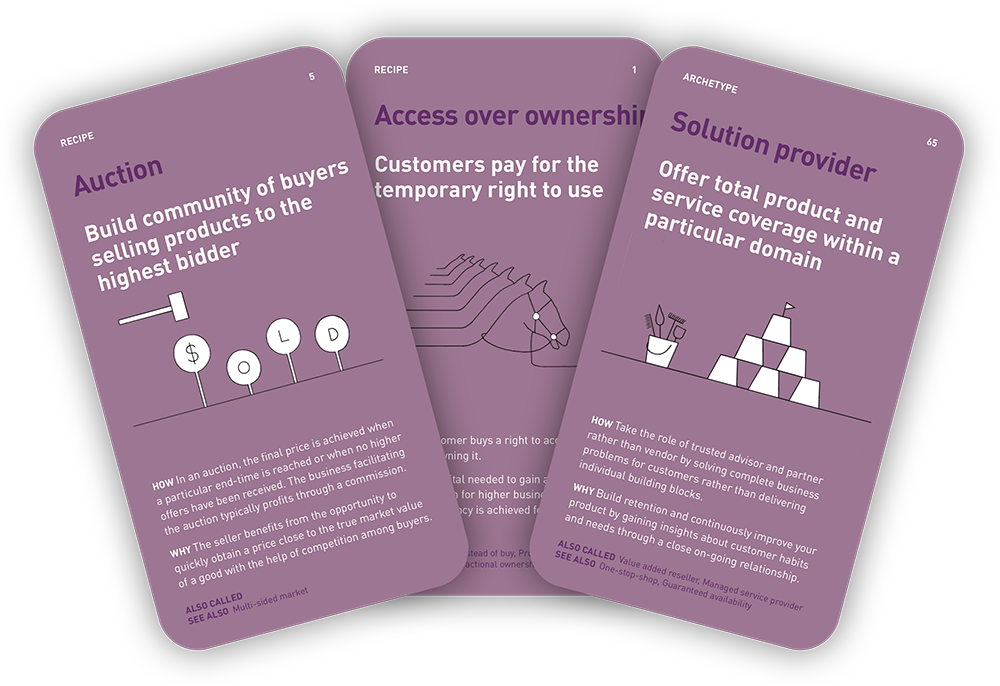Recipe
See also: Product Self-Service
| Key Partners | Key Activities | Value Propositions | Customer Relationships | Customer Segments | |||||
| Key Resources | Channels | ||||||||
| Cost Structures | Revenue Streams | ||||||||
How: Identify high cost process steps that add little perceived value for the customer. Find ways in which the customer can process those steps.
Why: Having customers take over steps in the value creation process reduces costs and can help increase the perceived value of the product itself, as the customer has a hand in production.
This business model is part of the Business Model Patterns printed card deck.
A collection of business models that will help you understand the key drivers of business model success. The card deck will be ready for purchase in the end of 2023 and is now undergoing rigorous testing.
Reserve your deck!Let your customers do the work
The Self-Service model is a unique approach to value creation in which a portion of the work is transferred to the customer in exchange for a reduced cost. This model is particularly effective for processes that generate high costs but offer relatively low perceived value for the customer.
In addition to the cost savings, customers typically find that Self-Service saves them time as well. They may even experience an increase in efficiency, as they are able to execute certain value-adding steps more rapidly and in a more targeted fashion. Classic examples of Self-Service include picking items off shelves, planning personal projects, and conducting payment transactions for products and services.
A Self-Service business has a significant savings potential and customer labor can often replace a significant number of staff positions. This is why the Self-Service model is an attractive option for companies looking to reduce costs and increase efficiency.
Where did the Self-Service business model pattern originate from?
The Self-Service business model had its origins in the United States, where it led to the establishment of Self-Service stores at the beginning of the twentieth century.
Traditionally, customers were always served at counters in small, family-owned stores. However, with the advent of Self-Service, customers were now required to fetch their own groceries from shelves.
The concept of Self-Service developed as a result of the general desire for increased productivity and efficiency that came with industrialization. Anecdotal evidence even suggests that Self-Service grew out of a situation where stressed customers became impatient and started helping themselves to items on shop shelves.
Over time, Self-Service stores became a familiar sight outside of North America as well. Sweden and Germany were among the first European nations to open Self-Service stores, in the 1930s and after the Second World War respectively.
Applying the Self-Service business model
The Self-Service pattern is well-suited for customers who are willing to take on additional work in exchange for lower prices. Additionally, this pattern can be beneficial when a DIY element in the manufacturing process creates perceived customer value, such as T-shirts that customers design themselves.
Analyzing the Potential from the Customer’s Perspective
In order to successfully implement the Self-Service model, it is essential to analyze the potential of the pattern from the customers’ point of view. This can help ensure that the model is well-received and that customers are willing to take on the additional work in exchange for lower prices.
Potential benefits of applying the Self-Service business modell
The Self-Service model offers a range of benefits for businesses, including cost savings, improved data collection, and increased revenue.
- Cost Savings. One of the primary advantages of the Self-Service model is that it allows businesses to reduce costs. With a self-serve approach, sales and customer support teams will no longer have to put customers on hold, which means less need to hire additional representatives each month.
- Improved Data Collection. Another benefit of the Self-Service model is that it allows for improved data collection. Human interactions can be unpredictable and not everything will be under a business’s control. However, when businesses adopt a self-serve approach, all of their funnels will be the same, which makes it easier to identify and fix flaws.
- Increased Revenue. At the end of the day, the primary goal of any business is to increase revenue. The Self-Service model can help achieve this by improving the user experience, making the business process more efficient, and opening the product to a wider audience. Additionally, when businesses approach new markets, such as offering their product in different languages or targeting adjacent users, they will not need to do a company-wide transformation to handle the new traffic; they will only need to adjust their funnels.
- Improved Customer Education. A strong focus on Self-Service can help improve customer education, as a natural part of the Self-Service transformation will be providing customers with educational resources that they can access at any time. This more practical and affordable way to educate customers can help increase engagement and reduce customer churn.
- Increase Engagement. Only educate customers during initial onboarding will not be sufficient for a Self-Service product or service. To maximize engagement, you need to support customers with educational resources across the entire customer journey. If your customers are remotely growth-orientated, they’ll thank you by sticking around as loyal customers.
Empower your customers
Consider to what degree you will allow customers to onboard themselves. The majority of the self-serve experience will consist of this period in the user journey, and it is crucial to make it as smooth as possible.
When does it make sense to make your product offering Self-Service?
Self-Service can be a strategic move for most SaaS businesses due to the benefits it offers, but there are cases where a Self-Service approach may not be the best fit.
When friction is good
While Self-Service software can help reduce friction and improve customer engagement, there are products that are so complex or features that are so crucial, that heavy engagement with customer support, customer success teams, or a meticulously crafted onboarding wizard is necessary for proper use. Without this degree of support engagement, users may not be able to activate the product.
An example of this is FullStory, software for recording browser sessions and playing them back. The product is almost completely useless if the user doesn’t install the FullStory JavaScript, which can be a tricky technical task. The company’s sign-up flow therefore includes a lot of friction, including the option to talk to an agent if needed.
An example of a product where Self-Service may not be the best approach is Coinbase, a digital wallet for storing and trading cryptocurrency. After previous wallet sites were hacked and users lost a significant amount of money, the crypto community has become very concerned about security and fraud. Registering on Coinbase therefore involves a very involved process, including sending ID to Coinbase that must be manually reviewed by an employee.
However, for products that are easy to use and do not have serious personal consequences for customers if used improperly, Self-Service software can be a smart choice. In practice, this is the case for most products. Even the above examples have automated as much of their user interaction as possible. An example of a product with a simple, Self-Service sign-up flow is Airtable, which is so frictionless that a new user can reach the UI in less than a minute and even reach the “Aha moment” on their own. The UI itself is also intuitive to use and requires almost no external integrations. In cases like this, heavy engagement with support would be a burden for both users and the company.
Trigger Questions
- How can we differentiate ourselves from traditional, full-service competitors in the market?
- What pricing strategy should we adopt to effectively market our Self-Service offering?
- Are we providing a level of value that aligns with customer expectations?
- Will customers view the added responsibilities they assume in the Self-Service model as a positive or negative experience?
- How can we ensure that the systems and procedures surrounding customer input are reliable and free from errors?
- How do you price Self-Service?
- Is the Self-Service work involved perceived as a positive experience?
- How would IKEA manage our business?
- Is your product or service simple enough for customers to understand and use on their own, without the need for human assistance?
- Have you considered the potential impact on your workforce and are you prepared to handle potential job losses or changes?
- How do you plan to handle customer complaints and issues that may arise as a result of Self-Service?
- How will you ensure the customer can still access customer service if they need help?
- How can you make sure that customer experience is not negatively impacted by the Self-Service model?
Examples
IKEA
Customers are integrated into value creation as they pick items from the warehouse and assemble furniture themselves.
Yotel
Travellers can collect room keys via lobby Self-Service kiosks and transform their bed into a couch, among other things.
Airbnb
Airbnb’s Self-Service business model allows hosts to list their properties and manage bookings on their own, without the need for assistance from a property management company. This not only improves the customer experience but also allows Airbnb to keep costs low and pass the savings on to customers in the form of lower prices.
Uber
Uber’s Self-Service business model allows riders to book and pay for rides on their own, without the need for assistance from a dispatcher. This not only improves the customer experience but also allows Uber to keep costs low and pass the savings on to customers in the form of lower prices.
Self-checkout at grocery stores
Self-checkout systems at grocery stores allows customers to scan and pay for their purchases on their own, without the need for assistance from a cashier. This not only improves the customer experience but also allows grocery stores to keep costs low and pass the savings on to customers in the form of lower prices.
McDonald's
The fast food giant McDonald’s bases its business model on the Self-Service concept, offering standardised menus in its restaurants in the form of franchises or run by the corporation itself. This reduces costs on waiting staff and other overheads, increasing customer throughput and profit.
BackWerk
The German bakery chain, BackWerk, allows customers to browse and select from a wide variety of products in glass-fronted display cases without the aid of store personnel. By allowing customers to take over some of the value creation process, the company greatly reduces its personnel costs and offers products at 30-45% less than traditional competitors.
Accor Hotels & Ibis
The French hotel group, Accor Hotels, uses Self-Service for its Ibis budget hotels. Guests obtain their rooms at a station similar to a vending machine without the assistance of professional receptionists and take their luggage to the room themselves. This reduces the number of staff in attendance throughout the hotel while still providing efficient Self-Service facilities.
Related plays
- Business Model Navigator by Karolin Frankenberger and Oliver Gassmann
- Self-service software model by User Pilot

